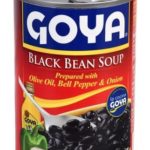Fall: A time to Savor the Flavors of Soup
September 25, 2018 • community
School of Public Health & Texas Center for Health Disparities Community Blog

It’s September. Football again takes up our weekends, the days are growing shorter, our minds turn to all things fall…including fall foods. Who doesn’t savor the flavors and scents of fall, bringing back memories of gatherings long ago? Fall foods are comfort foods and soups that feature in-season ingredients are the perfect touch for perking up chilly nights shared with family or friends. It’s the stories of those shared foods with the people who mean the most to us that conjure up the memories that will comfort us throughout the years.

Soups also have the capacity to be a great way to produce healthy meals on a limited budget. Consider traditional recipes like Chunky Lentil and Vegetable Soup just $5.24 for the entire recipe yielding 8 servings or canned such as Goya Black Bean Soup just $1.49 per 15 ounce can yielding about 2 main course servings. These all offer families a way to provide a nutrient-dense and richly satisfying main course for less than a dollar per serving. Just add a salad or corn bread to compliment the meal and round out the nutrient profile.
Dr. Spence-Almaguer found a way to bridge her husband’s loving feelings for his family’s traditional foods with her kid’s food preferences by putting a new spin on an old family favorite. “When I met my husband, he suggested I try cooking albondigas, a traditional Mexican soup with meatballs and vegetables. His mother taught me how to prepare her authentic version. My children wouldn’t eat chunks of vegetables and we needed to lighten our consumption of red meat, so I re-created the dish and submitted it to Cooking Light Magazine’s recipe contest. I pureed mixed bell peppers, fresh carrots, and canned tomatoes with the broth mixture and added yellow squash to the meatballs. Now I take pleasure in knowing that my children are eating a colorful dish of ‘hidden’ vegetables.” And, at the same time her husband gets to enjoy a familiar comfort food. The recipe was one of 12 finalists selected for competition and can be found online.

Interestingly, soups also benefit us in physiological ways that help us to feel full sooner and longer. Smooth soups tend to have the most benefits due to the higher rate of nutrient absorption causing a faster response to the brain that we are full (Clegg et al., 2013). Flood et al. proposed that enjoying a low-calorie soup prior to a meal has the potential to reduce energy intake in adults. Part of this response, due to the high liquid content of soups is caused by slower stomach emptying thus, a longer feeling of fullness. These studies reiterated what earlier researchers proposed that liquids in the form of soup can be more satisfying than solid foods, decrease hunger, increase fullness and reduce overall calorie intake (Kissileff et al., 1984; Himaya et al., 1998; & Rolls et al., 1990).
In addition, smells of foods can evoke vivid and detailed emotional memories of our past (Reid et al., 2014) due to the strong link between scents and emotional memory. Our personal history predisposes us to enjoy certain foods based on past comforts which are typically drawn from unhealthy foods (sugary and fatty). As a result, our coping mechanism may cause us to seek those foods rather than healthy foods (Gardner et al., 2014). This fall curl up with a nice aromatic bowl of your favorite comforting soup knowing that unlike traditional comfort foods, it’s nourishing, hydrating and good for both your body and soul.
Author:
Teresa Wagner, DrPH, MS, CPH, RD/LD, CHWI
Emily Spence-Almaguer, PhD, MSW
Clegg, M.E.; Ranawana, V.; Shafat, A.; Henry, C.J. Soups increase satiety through delayed gastric emptying yet increased glycaemic response. Eur. J. Clin. Nutr. 2013, 67, 8–11.
Flood JE, Rolls BJ. Soup preloads in a variety of forms reduce meal energy intake. Appetite 2007; 49: 626–634.
Gardner, Meryl P., et al. (2014), Better moods for better eating?: How mood influences food choice. Journal of Consumer Psychology. Vol 24, issue 3, pages 320-335.
Himaya A, Louis-Sylvestre J. The effect of soup on satiation. Appetite 1998; 30: 199–210.
Kissileff HR, Gruss LP, Thornton J, Jordan HA. The satiating efficiency of foods. Physiol Behav 1984; 32: 319–332.
Reid, C.A.; Green, J.D.; Wildschut, T.; Sedikides, C. Scent-evoked nostalgia (2015). Memory, 23, 157–166.
Rolls BJ, Fedoroff IC, Guthrie JF, Laster LJ. Foods with different satiating effects in humans. Appetite 1990; 15: 115–126.
Photo: https://betweennapsontheporch.net/roasted-pumpkin-soup-recipe-made-in-martha-stewart-cast-iron-pumpkin-casserole-dish/
Research reported in this publication was supported by the National Institute On Minority Health And Health Disparities of the National Institutes of Health under Award Number U54MD006882. The content is solely the responsibility of the authors and does not necessarily represent the official views of the National Institutes of Health.

Social media